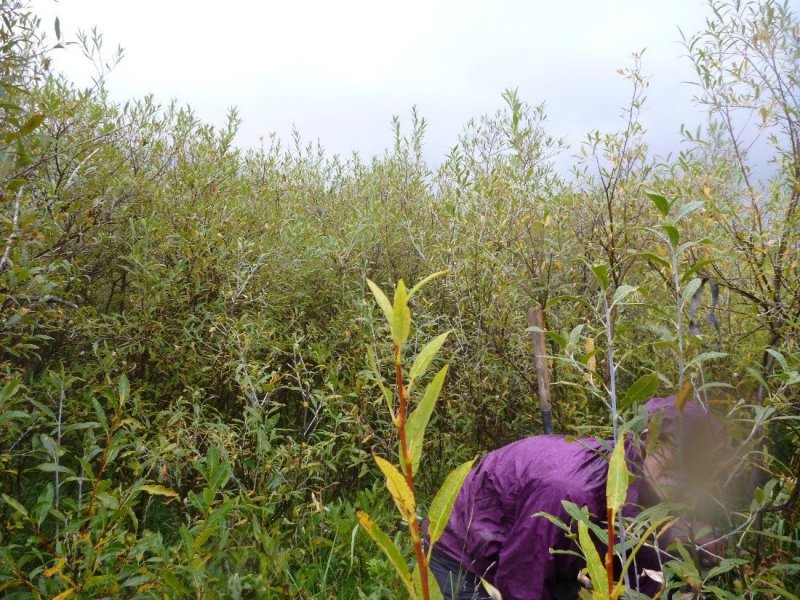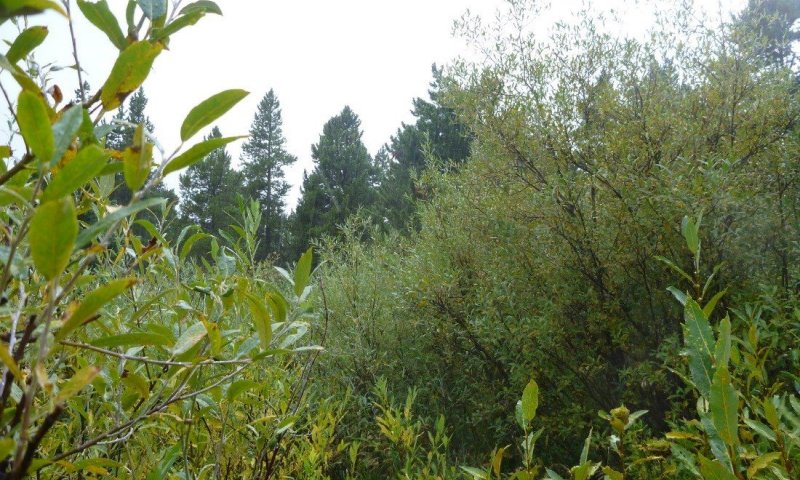

Natural Resources
Conservation Service
Ecological site R043AX974MT
Montane Swale Drummond’s willow (Salix drummondii)-alderleaf buckthorn (Rhamnus alnifolia)
Last updated: 3/11/2025
Accessed: 12/06/2025
General information
Provisional. A provisional ecological site description has undergone quality control and quality assurance review. It contains a working state and transition model and enough information to identify the ecological site.
MLRA notes
Major Land Resource Area (MLRA): 043A–Northern Rocky Mountains
This MLRA is located in Montana (43 percent), Idaho (34 percent), and Washington (23 percent). It makes up about 31,435 square miles (81,460 square kilometers). It has no large cities or towns. It has many national forests, including the Okanogan, Colville, Kootenai, Lolo, Flathead, Coeur d’Alene, St. Joe, Clearwater, and Kaniksu National Forests.
This MLRA is in the Northern Rocky Mountains Province of the Rocky Mountain System. It is characterized by rugged, glaciated mountains; thrust- and block-faulted mountains; and hills and valleys. Steep-gradient rivers have cut deep canyons. Natural and manmade lakes are common.
The major Hydrologic Unit Areas (identified by four-digit numbers) that make up this MLRA are: Kootenai-Pend Oreille-Spokane (1701), 67 percent; Upper Columbia (1702), 18 percent; and Lower Snake (1706), 15 percent. Numerous rivers originate in or flow through this area, including, the Sanpoil, Columbia, Pend Oreille, Kootenai, St. Joe, Thompson, and Flathead Rivers.
This area is underlain primarily by stacked slabs of layered sedimentary or metasedimentary bedrock. The bedrock formations range from Precambrian to Cretaceous in age. The rocks consist of shale, sandstone, siltstone, limestone, argillite, quartzite, gneiss, schist, dolomite, basalt, and granite. The formations have been faulted and stacked into a series of imbricate slabs by regional tectonic activity. Pleistocene glaciers carved a rugged landscape that includes sculpted hills and narrow valleys filled with till and outwash. Continental glaciation over road the landscape in the northern half of the MLRA while glaciation in the southern half was confined to montane settings.
The average annual precipitation is 25 to 60 inches (635 to 1,525 millimeters) in most of this area, but it is as much as 113 inches (2,870 millimeters) in the mountains and is 10 to 15 inches (255 to 380 millimeters) in the western part of the area. Summers are dry. Most of the precipitation during fall, winter, and spring is snow. The average annual temperature is 32 to 51 degrees F (0 to 11 degrees C) in most of the area, decreasing with elevation. In most of the area, the freeze-free period averages 140 days and ranges from 65 to 215 days. It is longest in the low valleys of Washington, and it decreases in length with elevation. Freezing temperatures occur every month of the year on high mountains, and some peaks have a continuous cover of snow and ice.
The dominant soil orders in this MLRA are Andisols, Inceptisols, and Alfisols. Many of the soils are influenced by Mount Mazama ash deposits. The soils in the area have a frigid or cryic soil temperature regime; have an ustic, xeric, or udic soil moisture regime; and dominantly have mixed mineralogy. They are shallow to very deep, are very poorly drained to well drained, and have most of the soil texture classes. The soils at the lower elevations include Udivitrands, Vitrixerands and Haplustalfs. The soils at the higher elevations include Dystrocryepts, Eutrocryepts, Vitricryands , and Haplocryalfs. Cryorthents, Cryepts, and areas of rock outcrop are on ridges and peaks above timberline
This area is in the northern part of the Northern Rocky Mountains. Grand fir, Douglas-fir, western red cedar, western hemlock, western larch, lodgepole pine, subalpine fir, ponderosa pine, whitebark pine, and western white pine are the dominant overstory species, depending on precipitation, temperature, elevation, and landform aspect. The understory vegetation varies, also depending on climatic and landform factors. Some of the major wildlife species in this area are whitetailed deer, mule deer, elk, moose, black bear, grizzly bear, coyote, fox, and grouse. Fish, mostly in the trout and salmon families, are abundant in streams, rivers, and lakes.
More than one-half of this area is federally owned and administered by the U.S. Department of Agriculture, Forest Service. Much of the privately-owned land is controlled by large commercial timber companies. The forested areas are used for wildlife habitat, recreation, watershed, livestock grazing, and timber production. Meadows provide summer grazing for livestock and big game animals. Less than 3 percent of the area is cropland.
LRU notes
This ecological site resides in MLRA 43A in the Livingston-Lewis-Apgar Mountains which includes the bulk of Glacier National Park (GNP) and the lower western valley portions along the Flathead River. The landscape is mountains and landforms include glaciated mountains with associated features such as U-shaped valleys, mountain slopes, alpine ridges, cirques, valley floors and moraines. Glaciation of this area was in the form of alpine, icecaps and valley outlet glaciers. It also includes associated alluvium and outwash features. This area includes low valleys to tall mountains with elevation ranging 989-2,762 m (3,250-9,050 ft.). The climate is cold and wet with mean annual air temperature of 3 degrees Celsius (37 degrees F.), mean frost free days of 65 days and mean annual precipitation of 1295 mm (51 in.) and relative effective annual precipitation is 169 cm (66 in.). The soil temperature regime is cryic and the soil moisture regime is udic. The geology of this area is dominated by metasedimentary rocks of the Belt Supergroup (Grinnell argillite and Siyeh limestone) with minor Tertiary sediments. Soils are generally weakly developed on mountain slopes within U-shaped valleys. Parent materials are commonly of colluvium, till, and residuum from metasedimentary rocks. Limestone bedrock within this part of the Belt Supergroup is not highly calcareous and due to high precipitation received in this area most carbonates at mid and upper elevations have been leached from the soil profiles. Bedrock depth varies greatly with location, landform and slope position. Volcanic ash is often found in the soil surface with various degrees of mixing. Thicker volcanic ash can be found on more stable positions on mid and upper elevation slopes that are protected from wind erosion. Volcanic ash is not typically found in low elevation areas on stream and outwash terraces associated with streams and rivers. There are numerous large lakes including St. Mary, Bowman, Kintla, Lake Sherburne, Logging, Upper Waterton and numerous creeks (
Classification relationships
NPS Plant Community Name: Salix drummondiana Temporarily Flooded Shrubland Alliance (Salix drummondiana/Calamagrostis canadensis Shrubland) CEGL002667.
Ecological site concept
Ecological Site Concept
These sites are primarily in swales or drainageways on glacial moraines or glacial valley floors, but can also occur in sloughs in floodplains. Shrubby swale sites are dominated by the tall statured shrub Drummond’s willow (Salix drummondiana). Other willows, particularly Booths willow (Salix boothii) and Bebbs willow (Salix bebbiana) other shrub species including twinberry honeysuckle (Lonicera involucrata), alderleaf buckthorn (Rhamnus alnifolia), prickly currant (Ribes lacustre) and common snowberry (Symphoricarpos albus) can be present at the site. On hummocks within the understory of the willow dominated swale, moss species dominate along with obligate wetland species purple marshlocks (Comarum palustre), bog laurel (Kalmia polifolia) and dwarf red blackberry (Rubus pubescens). The understory is generally dominated by the grasses, bluejoint (Calamagrostis canadensis), mountain brome (Bromus marginatus) and rough bentgrass (Agrostis scabra), with a variety of sedge species including smallwing sedge (Carex microptera) and golden sedge (Carex aurea). A variety of forbs are present including fireweed (Chamerion angustifolium), field horsetail (Equisetum arvense), fragrant bedstraw (Galium triflorum), common cowparsnip (Heracleum maximum), feathery false lily of the valley (Maianthemum racemosum), wild mint (Mentha arvensis), western sweetroot (Osmorhiza occidentalis), alpine leafybract aster (Symphyotrichum foliaceum), western meadow-rue (Thalictrum occidentale), stinging nettle (Urtica dioica) and American vetch (Vicia americana). When this ecological site is found near the vicinity of a beaver dam, then the water table will be higher, ponding will last for a longer duration and the understory will be dominated by the sedges Northwest Territory sedge (Carex utriculata) and or shortstalk sedge (Carex podocarpa). Soils found on these sites are very deep, very poorly to somewhat poorly drained and have a water table that fluctuates seasonally. Soils are typically mostly mineral soils, but organic material may be present although not in enough thickness to classify the soils in the Histosols soil order. The soil parent material is typically alluvium, outwash or till derived from metamorphic and sedimentary rock. The ground surface usually has high litter cover and very low bare soil due to the abundant vegetation cover. These soils are within the following taxonomic subgroups: Oxyaquic Argicryolls, Typic Cryaqualfs, and Cryaquents. Diagnostic features include a dark mollic epipedon or an ochric epipedon, a zone of clay accumulation in an argillic horizon, and endosaturation and/or a reduced matrix due to the presence of a water table. Soils that have more of an organic surface layer may also have fibric soil materials. Clay at the surface ranges 20-23 percent, while within 20 cm of the surface clay content ranges higher from 23-38 percent. Organic layer thickness covering the surface ranges 2-5 cm in thickness.
Associated sites
| F043AX951MT |
Lower Subalpine Cool Dry Coniferous subalpine fir- Engelmann spruce/ Sitka alder/ thinleaf huckleberry/ common beargrass 43A Lower Subalpine Coniferous Cool Moderately Dry, (ABLA/CLUN2-XETE) ecological site is found in cool, moderately dry mid-elevations that span the lower subalpine areas. It is found primarily on lateral moraine and glacial valley wall landforms, on back or footslope positions, at elevations ranging 1,000 to 2,100 meters (3,300-6,900 feet), on all aspects and on moderate to steep slopes ranging 10-35 percent.The 43A Lower Subalpine Coniferous Cool Moderately Dry, (ABLA/CLUN2-XETE) site has soils associated with this Ecological Site that are very deep and well drained. These soils have developed in glacial till or colluvium parent materials derived from metasedimentary rock that typically have varying amounts of influence of volcanic ash in the soil surface layers. The dominant taxonomic soil order associated with these soils is Inceptisols with Andic subgroups indicating that there is 18 to 37 (7-14.5 inches) centimeters of volcanic ash. The 43A Lower Subalpine Coniferous Cool Moderately Dry, (ABLA/CLUN2-XETE) ecological site has a reference vegetation community with an overstory of subalpine fir and Engelmann spruce with an understory of Sitka alder, huckleberry, beargrass and queencup bead lily. |
|---|
Table 1. Dominant plant species
| Tree |
Not specified |
|---|---|
| Shrub |
(1) Salix drummondiana |
| Herbaceous |
(1) Calamagrostis canadensis |
Click on box and path labels to scroll to the respective text.





